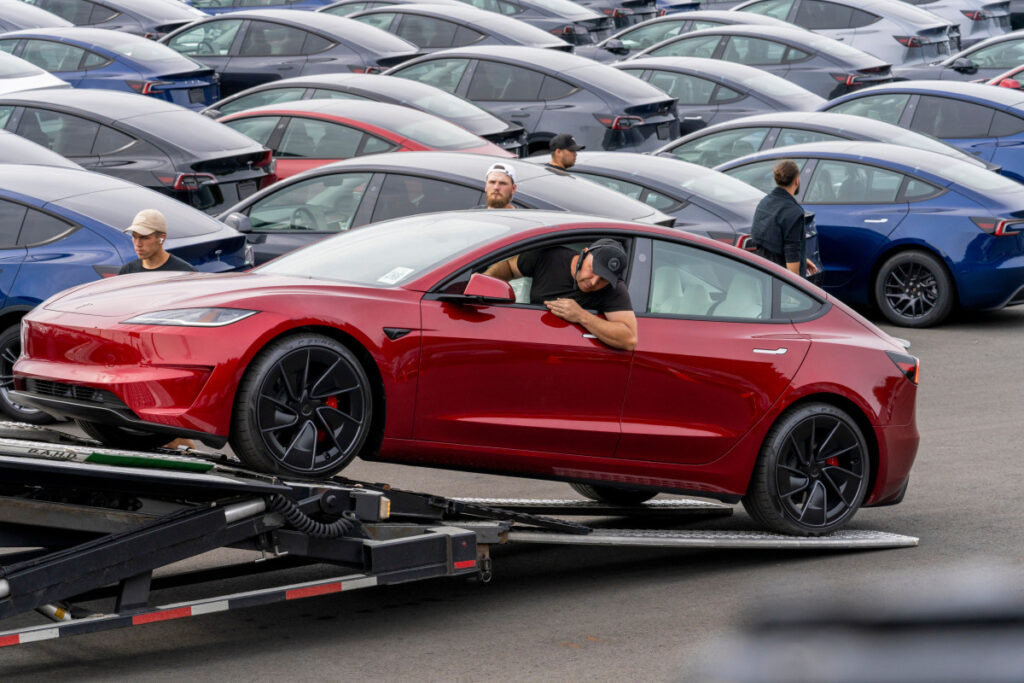During a recent pop-in visit to a Tesla (TSLA) store while shopping at my local mall, two older teenagers interrupted a conversation I was having with a sales rep about the latest iteration of the Model 3.
While I was hearing the salesperson talk about the updated styling of Tesla’s compact sedan, they asked a question about the car’s insides. It got my attention:
“Ayo, boss, is it true these catch fire?”
Although such incidents are a regular subject of headlines and Facebook (META) posts shared by family members who are skeptical about EVs, EV fires are real, but are much rarer than you might think.
Don’t miss the move: Subscribe to TheStreet’s free daily newsletter
According to a 2023 report by the Swedish Civil Contingencies Agency, there were 3.8 fires per 100,000 electric or hybrid cars in 2022, compared with 68 fires per 100,000 cars which also includes fuel types like diesel and hydrogen.
Additionally, Tesla’s own global data shows between 2012 and 2022, one Tesla vehicle caught fire for every 130 million vehicle miles traveled, compared to NFPA and U.S. Department of Transportation (USDOT) data showing one car fire occurred in the U.S. for every 68 million vehicle miles traveled.
Despite the data, the clips and pictures of burning Teslas and other EVs spread across the net are enough to keep many skeptical people skeptical about EVs. However, a battery supplier to Ford and Tesla may have solved the problem for good.
LG Chem’s EV battery breakthrough
In a new announcement, South Korean LG Chem, the parent company of EV battery supplier LG Energy Solution, said it has devised an ingenious solution to combat EV fires by preventing them from happening in the first place.
In a collaborative effort with a special team of engineering academics from the Pohang University of Science and Technology (POSTECH) in Pohang, South Korea, LG battery researchers developed a special layer that can be used inside the battery itself to suppress thermal runaway. This phenomenon causes EV batteries to ignite infernos that seem impossible to extinguish.
Several factors can cause thermal runaway in an EV battery, including, but not limited to cell damage, prolonged flood damage, crashes or short circuits. The act of thermal runaway describes the phenomenon when a battery overheats uncontrollably to a point where it can keep burning without consuming any oxygen.
As the battery cells get hotter, neighboring cells get hotter, causing a chain reaction that can ultimately lead to the battery catching fire or exploding.
More Business of EVs:
- A ridiculous Tesla Supercharging flaw is making EV owners hostile
- Study: EV charging stations have a secret built-in business benefit
- Mercedes latest tech is ahead of Tesla in one key area
While many modern EVs have safeguards like sensors and cooling systems protecting the battery, thermal runaway can still happen.
The folks from LG Chem and POSTECH claim this can be a thing of the past with something installed to the batteries called a “safety reinforced layer.”
According to LG, the thermal runaway suppression material developed in collaboration with POSTECH is a composite material that changes its electrical resistance based on temperature. Placed between the cathode and the current collector, the device has a similar function as a fuse, where it blocks the flow of electricity when a battery starts to overheat, which is about 90 to 130 degrees Celsius (or 194-266 degrees Fahrenheit).
When at that temperature, the material suppresses the heat by altering its molecular structure and blocking the flow of electricity through the battery.
Related: A ridiculous Tesla Supercharging flaw is making EV owners hostile
LG tested this technology with both nickel-cobalt manganese (NCM) and lithium-cobalt oxide (LCO) batteries. The researchers found that when 10 kilogram (22 pound) weights were dropped on them, the LCO batteries caught fire 84% of the time, and the NCM batteries caught fire 100% of the time.
However, when adding their experimental material as intended, the researchers claimed the rate of fire in the treated lithium batteries dropped to zero percent. However, the nickel batteries only caught fire 30% of the time and were extinguished by the experimental material within seconds.
The timing of this breakthrough comes at a time of distrust of EVs in South Korea. According to Korea JoongAng Daily, authorities in the country’s capital and largest city, Seoul, have been rocked by a horrific EV fire in an underground parking garage in Incheon. The fire damaged 880 nearby vehicles and left 1,600 households without electricity and water for a week.
As a result, the Seoul Metropolitan Government is proposing new rules that would restrict EVs charged over 90% from accessing underground parking garages and enforce a charging limit of 80% on rapid charges within the Seoul metro area.
LG says it plans to continue safety testing to implement this tech in “large-capacity electric vehicle batteries” through 2025. LG Chem CTO Lee Jong-gu stated he is confident about what these breakthroughs can do for the tough EV market.
“This is a tangible research achievement that can be applied to mass production in a short period of time,” he said. “We will enhance safety technology to ensure customers can use electric vehicles with confidence and contribute to strengthening our competitiveness in the battery market.”
Related: Veteran fund manager sees world of pain coming for stocks
